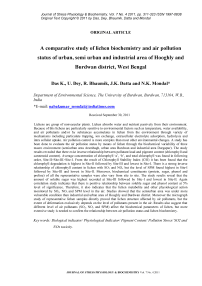A comparative study of lichen biochemistry and air pollution status of urban, semi urban and industrial area of Hooghly and Burdwan district, West Bengal
Автор: Das K., Dey U., Bhaumik R., Datta J.K., Mondal N.K.
Журнал: Журнал стресс-физиологии и биохимии @jspb
Статья в выпуске: 4 т.7, 2011 года.
Бесплатный доступ
Lichens are group of nonvascular plants. Lichen absorbs water and nutrient passively from their environment. Because of this lichens are particularly sensitive to environmental factors such as temperature, water availability, and air pollutants and/or by substances accumulates in lichen from the environment through variety of mechanisms including particulate trapping, ion exchange, extracellular electrolyte adsorption, hydrolysis and intra cellular uptake. Air pollution control is more complex than most other environmental changes. A study has been done to evaluate the air pollution status by means of lichen through the biochemical variability of three macro environment (semiurban area Arambagh, urban area Burdwan and industrial area Durgapur). The study results revealed that there exist inverse relationship between pollutant load and pigment content (chlorophyll and carotenoid content). Average concentration of chlorophyll 'a', 'b', and total chlorophyll was found in following order, Site-II>Site-III>Site-I. From the result of Chlorophyll Stability Index (CSI) it has been found that the chlorophyll degradation is highest in Site-II followed by Site-III and lowest in Site-I. There is a strong inverse relationship of chlorophyll content in lichen with SO2and NOxbut the level of SPM found highest in Site-I followed by Site-III and lowest in Site-II. Moreover, biochemical constituents (protein, sugar, phenol and proline) of all the representative samples were also vary from site to site. The study results reveal that the amount of soluble sugar was highest recorded at Site-III followed by Site-I and lowest in Site-II. Again correlation study indicates that there is positive relationship between soluble sugar and phenol content at 5% level of significance. Therefore, it also indicates that the lichen metabolite and other physiological action monitored by SO2, NOx SPM level in the air. Studies showed that the semiurban area was under more vulnerable condition than industrial and urban area of Hooghly and Burdwan district. Moreover the micrograph study of representative lichen samples directly proved that lichen structure affected by air pollutants, but the extent of deformation exclusively depends on the level of pollutants present in the air. Results also suggest that different level of air pollutants (SO2, NOxand SPM) affect the biochemical parameters of lichen, but more extensive study is needed to confirm the relationship between air pollution status and lichen biochemistry.
Biological indicator, physiological indicator, pigment content, pollution stress, so2 and nox toxicity
Короткий адрес: https://sciup.org/14323561
IDR: 14323561
Текст научной статьи A comparative study of lichen biochemistry and air pollution status of urban, semi urban and industrial area of Hooghly and Burdwan district, West Bengal
NO x toxicity.
Lichens are group of nonvascular plants. It’s a symbiotic relationship between algal (photobiont)
and fungal (mycobiont) species. It’s composed of outermost layer cortex, symbiotic layer and medulla which containing algae. Lichens are recognised in a class according to name of fungal partner. Lichens are generally unicellular organism with complex fillamentus structure, associate to form plant like structure are referred to as thalli. Morphologically varying these are with shape, size, colour and structure.
Lichen absorbs water and nutrient passively from their environment. Because of this lichens are particularly sensitive to environmental factors such as temperature, water availability, and air pollutants and/or by substances accumulate in lichen from the environment through variety of mechanisms including particulate trapping, ion exchange, extracellular electrolyte adsorption, and hydrolysis and intra cellular uptake. Various particles are embedded on lichen thallus under moist or dry condition (Nieboer et al., 1978).
An important management all over the world is to determine an effect on lichen by air pollution, due to their sensitivity to numerous gasses. Because of this lichens are recognised a good pollution indicator. Possible changes in lichen due to air pollution decrease in thallus size and fertility (Sigal and Nash, 1983), chlorophyll degradation, changes in photosynthesis, respiration, membrane leakage, lichen cover, morphology, community structure and reproduction (Stolte et al., 1993).
Lichens are unable to survive in air pollutant abandoned area and it is estimated that lichens are highly sensitive to sulphur dioxide (SO 2 ). In case of sulphur dioxide (SO 2 ) natural background concentration is 0.28 to 2.8 µg/m3, but values near pollution sources can rise to as high as 200 µg/m3 or more. Most lichen cannot survive extended period of SO 2 exposure above 60 µg/m3 (Hale, 1981).
Lichens are also adversely affected by short term exposure of nitrogen dioxide (NOx). NOx and other nitrogenous compounds are component of acid rain and photo oxidants. Effects of NOx are generally expressed in loss of chlorophyll pigment (Tiwari, 2008).
Protein and sugar content of lichen was reduced due to the effect of SO 2 , NO x and to some extent contribution of dust and metal. In some cases protein content of lichen increase directly proportional to the air pollutant and/or air pollution stress, it may be due to some other factors (Bouchelaghem et al., 2011). Whereas proline secretion increases under stress condition (Ewald and Schlee, 1983).
At low pollution level of enzyme system within thallus may become activated. This can be observed in the form of increase in actively in glucose-6-phosphate dehydrogenase or increase in the levels of glutathione and total protein.
Keeping in mind the above facts the present work was confined to know the deleterious effects of air pollutants on lichen biochemical changes.
MATERIALS AND METHODS
Site Description
The study was conducted at Arambagh (220 53’ 14.09” N and 870 46’ 56.84” E) area of Hooghly district, Golapbag (230 15’ 13.72” N and 870 51’ 01.92” E) area of Burdwan district and Durgapur (230 39’ 03.00”N and 870 06’ 02.3”E) area of Burdwan district. The elevation of these three respective sampling sites from sea surface are 21 m, 40 m, and 76 m of Arambagh, Burdwan and Durgapur area respectively.
Sample Availability
The samples were collected from the target sites and immediately placed it in labeled plastic packet and samples were stored at 4 0C and subsequently processed within 7 days of collection. The systematic of lichen indicates that three varieties of lichen are found in the three experimental areas. The morphological structure of lichen indicate that, these are belongs from the morphological type of crustose. The thallus of this type lichen is insignificant size, flat and thin usually without any distinct lobes. This type of lichen just like a thin layer or crust closely attached by the whole of its lower surface of tree. The experimental lichens are collected from Shorea robusta, Citrus maxima, Areca catechu, Mangifera indica trees with the genus Graphic.
Analytical Parameters
The air pollutant (SO 2 , NO x and SPM) was measured by HANDY SAMPLER (Model No. APM 821). The concentration of SO 2 , NO x , SPM were measured by using the method West and Gaeke, 1956 along with API by Rao and Rao, 1989.
Biochemical parameters are include chlorophyll (Arnon, 1949), chlorophyll stability index (Koleyoreas, 1958), carotinoid, protein (Lowry et al., 1951), sugar (Mc. Cready et al., 1950), phenol (Malik and Singh, 1980), proline (Bate et al., 1973). These parameters are done along with the conductivity (Garty et al., 1997) and pH (Garty et al., 1997).
Micrograph study was done by the method of Robards A.W., Wilson A.J. 1993. The samples were thoroughly washed with double distilled water for removing the dirt and then treat with glutaraldehyde (2.5 %), alcohol (50 and 70 %) and finally dried and sputter coated with gold palladium (IB-2 ion coater) before mounted at alluminium stubs. The photograph was taken by Scanning Electron Microscope (Hitachi S-530).
RESULTS
The result showed that there is significant variation in chlorophyll content in three study sites. The average concentration of chlorophyll ‘a’, ‘b’ and total chlorophyll was found in order, Site-II>Site-III>Site-I (Fig. 2). The concentration of chlorophyll is low in Site-I followed by Site-III and Site-II respectively, which may be due to pollution stress. The carotenoid concentration varied similarly as chlorophyll content in three experimental sites (Table 1). The higher carotenoid content was recorded from comparatively undisturbed area of Site-II with respect to Site-I and Site-III (Table 1). This is also supported by API value of three experimental sites (Table 5). The study results also revealed that there is a strongly negative relationship between chlorophyll level and the SO 2 at 5 % level of significance (Fig. 2) (Table 6). Again more acidic pH of lichen extract found in Site-III compare to Site-II and Site-I (Table 3) (Fig. 4). Although the pH value of lichen does not support the total chlorophyll content at Site-II. There is a strong inverse relationship of chlorophyll content in lichen with SO 2 , NOx and SPM in three experimental sites (Table 6). From the result of Chlorophyll Stability Index (CSI), it has been found that the chlorophyll degradation is highest in Site-II followed by Site-III and lowest in Site-I (Fig. 3). Conductivity study of the lichen extract revealed that the Site-I is highest followed by Site-III and lowest in Site-I (Table 3).
Table 1 Pigment content in different representative samples. (each values are average of 5 samples).
|
Sampling sites |
Chloroiphyll ‘a’ (mg/g f.w) |
Chlorophyll ‘b’ (mg/g f.w) |
Total chlorophyll (mg/g f.w) |
Carotinoid (mg/g f.w) |
|
Site-I |
0.626 |
0.325 |
1.030 |
0.002 |
|
Site-II |
0.849 |
0.478 |
1.551 |
0.016 |
|
Site-III |
0.688 |
0.416 |
1.401 |
0.002 |
|
LSD(5%) |
0.189 |
0.117 |
0.319 |
0.004 |
LSD: Least significant difference at 5 % level of significance
Table 2 Chlorophyll Stability Index of experimental samples. (each values are average of 5 samples).
|
Sampling sites |
Total chlorophyll In normal condition. (mg/g f.w) |
Total chlorophyll after heating at 560C temperature.(mg/g f.w) |
Difference in total chlorophyll content. (mg/g f.w) |
|
Site-I |
1.030 |
0.185 |
0.845 |
|
Site-II |
1.551 |
0.145 |
1.406 |
|
Site-III |
1.401 |
0.132 |
1.269 |
|
LSD(5%) |
0.319 |
0.085 |
0.449 |
LSD: Least significant difference at 5 % level of significance
Table 3 Representing pH and Conductivity. (each values are average of 5 samples).
|
Sampling sites |
pH |
Conductivity (mS/cm) |
|
Site-I |
7.3 |
6.66 |
|
Site-II |
6.4 |
21.27 |
|
Site-III |
6.6 |
2.66 |
|
LSD(5%) |
1.1 |
11.50 |
LSD: Least significant difference at 5 % level of significance
Table 4 Variation of secondary metabolite and other metabolic. (each values are average of 5 samples).
|
Sampling sites |
Protein (%) |
Sugar (%) |
Phenol (%) |
Proline ( µ g/mole) |
|
Site-I |
2.66 |
1.76 |
0.38 |
23.77 |
|
Site-II |
10.66 |
0.25 |
0.58 |
7.52 |
|
Site-III |
12.66 |
7.33 |
1.03 |
4.09 |
|
LSD(5%) |
5.50 |
1.53 |
0.32 |
11.61 |
LSD: Least significant difference at 5 % level of significance
Table 5 Concentration of SO 2 , NOx, and SPM at different experimental sites. (each values are average of 5 samples).
|
Sampling sites |
SO 2 ( µ g/m3) |
NO x ( µ g/m3) |
SPM ( µ g/m3) |
Air pollution index ( µ g/m3) |
|
Site-I |
5.22 |
298.74 |
374.00 |
243.63 |
|
Site-II |
4.39 |
292.73 |
252. 66 |
225.24 |
|
Site-III |
4.49 |
266.46 |
348.76 |
233.56 |
|
LSD (5%) |
1.03 |
66.95 |
139.00 |
|
|
LSD: Least significant difference at 5 % |
level of significance |
|||
Table 6 Correlation between lichen bio-chemical parameter.
|
T Chl |
Car. |
pH |
Protein |
Sugar |
Phenol |
Proline |
SO 2 |
NOx |
|
|
Car. |
0.578 |
||||||||
|
pH |
-0.235 |
-0.324 |
|||||||
|
Protein |
0.649* |
0.198 |
-0.373 |
||||||
|
Sugar |
-0.062 |
-0.638 |
-0.203 |
0.388 |
|||||
|
Phenol |
0.510 |
-0.210 |
-0.103 |
0.679* |
0.639* |
||||
|
Proline |
-0.721 |
-0.197 |
0.424 |
-0.639 |
-0.308 |
-0.624 |
|||
|
SO 2 |
-0.750* |
-0.333 |
-0.113 |
-0.574 |
0.036 |
-0.551 |
0.226 |
||
|
NOx |
-0.194 |
0.101 |
-0.598 |
-0.374 |
-0.162 |
-0.349 |
0.227 |
0.241 |
|
|
SPM |
-0.404 |
-0.724 |
0.036 |
-0.161 |
0.256 |
-0.027 |
-0.025 |
0.454 |
0.147 |
*p<0.05
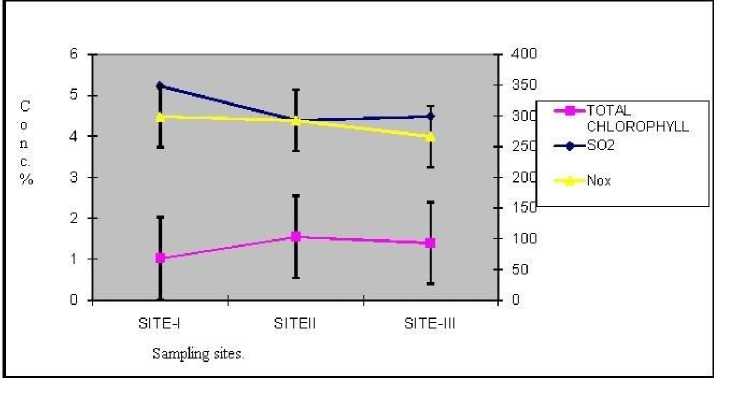
Fig. 2 Relationship between T.C, SO 2 and NO x .
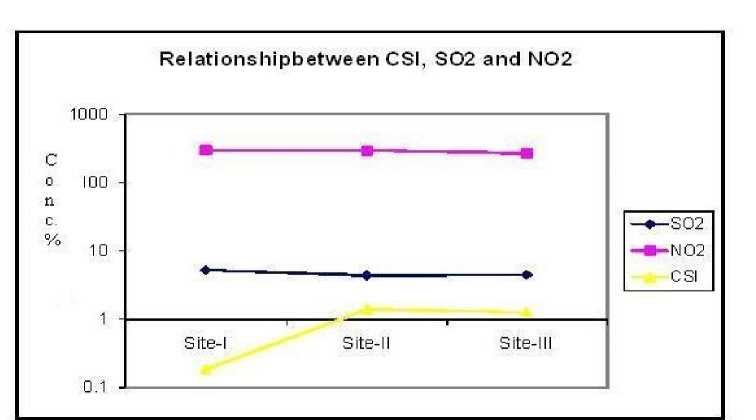
Fig. 3 Relationship between CSI, SO 2 and NO x
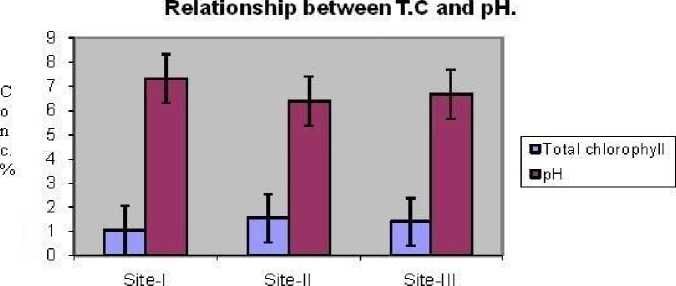
Sampling sites
Fig. 4 Relationship between T.C and pH
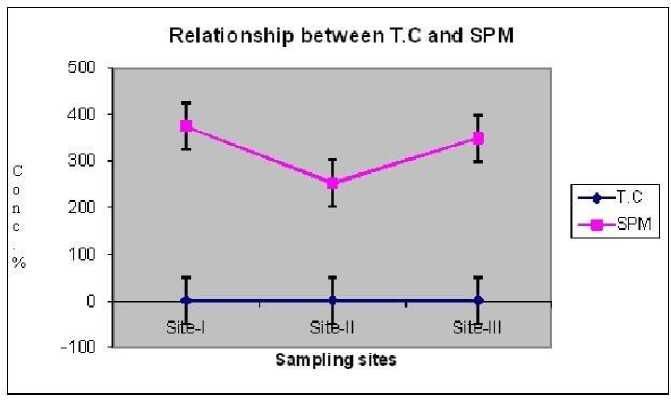
Fig. 5 Relationship between T.C and SPM.
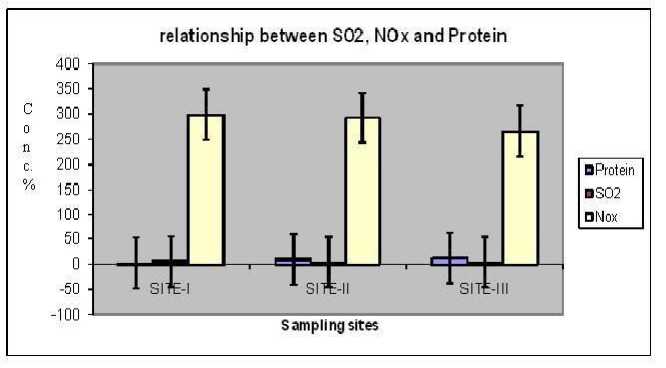
Fig. 6 Relationship between SO 2 , NO x and Protein.
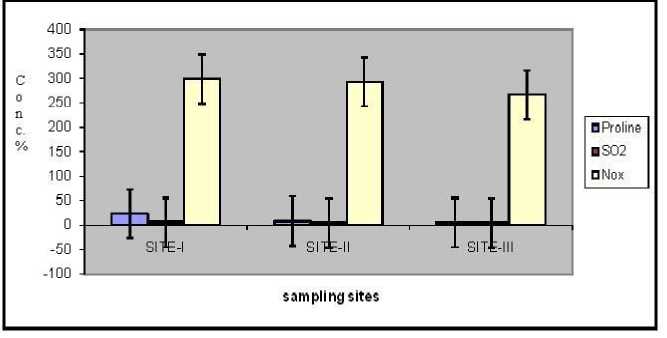
Fig. 7 Relationship between SO 2 , NO x and Proline.
T.Chl: Total chlorophyll; Car: Carotinoid.
The results of biochemical parameters including soluble sugar was evaluated highest in Site-III followed by Site-I and Lowest in Site-II (Table 4). The variation of protein content in different experimental sites is shown in table 4. The highest protein was recorded at Site-III followed by Site-II and lowest in Site-I (Table 4). But also higher proline level was noted at Site-I followed by Site-II and lowest in Site-III (Table 4). Similarly total phenol was evaluated and highest phenol was
recorded at Site-III followed by Site-II and lowest in Site-I (Table 4). The level of SO 2 was highest in Site-I followed by Site-III and Site-II respectively. Results of NO x are highest in Site-I like SO 2 and followed by Site-II and Site-III and the level of SPM is very similar as SO 2 level (Table 5). Finally the Scanning Electron Microscope study was conducted to examine the internal structure of lichen shown in
Fig. 8.
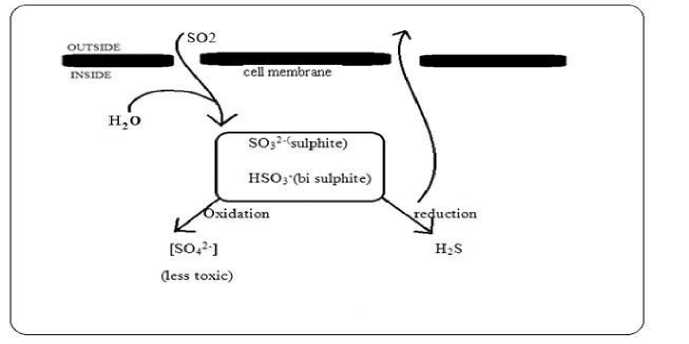
Fig. 1 Entry of pollutant, sulphur dioxide and its detoxification in lichen (hypothetical) (Hopkins, 1999).
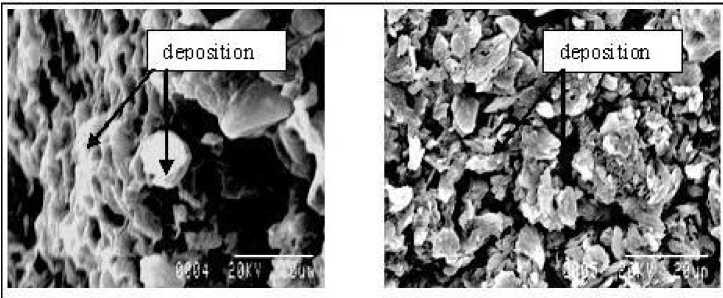
Fig: 8.a. Fig: 8.b.
(Fig: 8. a,b. representing the distorted picture of Site-I. It doesnot showed any clear structure.)
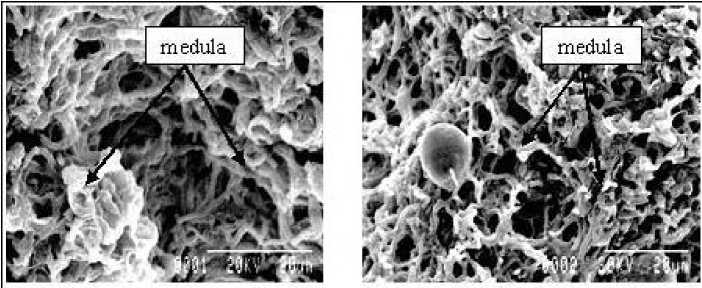
Fig: 8.c. Fig: 8.d.
(Fig: 8.c, d. representing comparatively clear picture of S ite-II, any deposition were does not showed in this picture.)
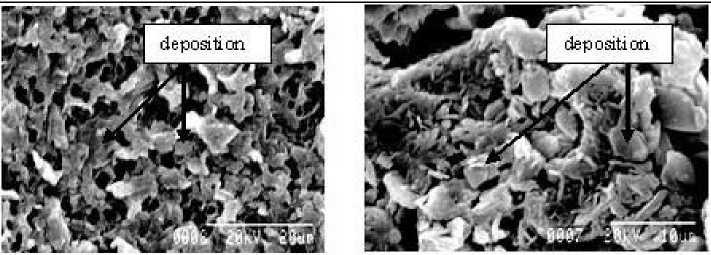
Fig: 8.e. Fig: 8.f
(Fig: 8.e, f representing the picture of Site-Ш, which shows cortex but does not show any clear structural property.)
DISCUSSION
The status of chlorophyll primarily indicate that the lichen pigment concentration highly affected by air pollutants. The correlation the result of chlorophyll content and pollutant (SO2, NOx and SPM) concentration indicate that the lower concentration of chlorophyll mainly due to pollution stress. This type of pollutant increases the activity of glucose-6-phosphate dehydrogenase or increase the level of glutathione and total protein (Tiwari, 2008). It is observed that chlorophyll content of lichen is dependent on pollution stress and it generally highest in unpolluted area (Fig. 2) (Backor et al., 2003). Again it is well documented that chlorophyll was inversely proportional to the SO2 concentration (Le balance and Robitaille, 1976).
It is generally reported that carotinoid content highest in polluted area but the study results indicate that it is highest in comparatively less polluted area. This is probably due to other causes such as vegetation type, climatic condition etc. (Rout et al., 2010). Cholophyll degradation measurements were intended as parameter of air pollution experiment. The high CSI indicate the difference in pigment concentration is low in after heating at 56 0C than normal condition. Therefore it maybe concluded that the high CSI value supported the availability of chlorophyll in the plant material and the plants ability to withstand stress condition (Babu et al., 2009) (Fig. 3).
From the Fig: 4 it is clear that more acidic pH of lichen extract supported the lower concentration of chlorophyll in Site-III, compare to other two sites and that is probably due to SO 2 toxicity (Farmer et al., 1992). The conductivity study revealed that the variation of conductivity is due to heavy metals, H+ ions etc.
The same relationship was noted between the chlorophyll and the concentration of SO2 and NOx (Table 6). Moreover dust was also influenced chlorophyll degradation in lichen (Garty et al., 1997) (Fig. 5). Both SO2 and NOx have strong influence on chlorophyll level. This is probably due to the fact that gaseous pollutants like SO2 and NOx entry in to the lichen, following the same diffusion pathway as CO2, accordingly lichen are, most susceptible to these pollutants during day light hours under conditions conducive to lichen spore opening. Once the gaseous component enters into the lichen, both SO2 and NOx readily dissolve in apoplastic water to produce mainly sulphite and bi-sulphite ions (SO32-, HSO3-) or Nitrite and Nitrate (NO2-, NO3-), respectively. Sulphite, Bi-sulphite and Nitrite are toxic at sufficiently high concentrations. Even nitrite can be toxic at sufficiently high concentrations, but at lesser concentrations both nitrite and nitrate can be metabolised through nitrogen reduction (Hopkins, 1999). The hypothetical mechanism of toxicity and de-toxicity are shown in the following Fig. 1. The primary site of SO2 injury appears to be the chlorophyll pigment. The study results also revealed that there is strongly negative relationship between chlorophyll level and the concentration of SO2 at 5% level of significance (Fig. 2) (Table 6). Moreover, total chlorophyll levels also showed strongly negative relationship at 1% level of significance (Table 6). Actually the concentration of SO2 as low as 0.035 µl/l. of air will cause disruption on chloroplast membranes. Higher concentration will damage the plasmalemma and other membranes, inhibit enzymes (including Rubisco and PEP carboxylase) and generally disrupt metabolism. Disruption of chloroplast membrane and breakdown of chlorophyll give rise to visible symptoms of injury such as bleaching of lichen. Sulphur dioxide is the principle factor responsible for disappearance of lichen from polluted area. Rao and Le Blance (1966) observed degradation of chlorophyll ‘a’ and ‘b’ to their respective phaeophytins and alteration of cellular structure. This phenomenon was proved through a study by Nash, 1973, using four lichen species which were fumigated at 5ppm SO2 for 24 hours. Similarly, NOx also damage the lichen structural pattern. Although direct interaction of NOx and lichen is limited (Sutton. et al., 2004). Basically at tropospheric ozones formed by the action of sunlight on nitrogen dioxide, which subsequently damage the ultra structure of lichen cell and its organelles and subsequently inhibit critical metabolic pathways such as photosynthesis and respiration. The present finding also corroborated with proposed mechanism. The level of total chlorophyll showed negative relationship with NOx level (Table 6). On the other hand higher proline was noted in Site-I compare to the Site-II and Site-III. Again Air Pollution Index (API) value supported the above fact. The high level of proline and CSI showed (Fig. 7) that the plant has the ability to convert the glutathione in to proline and this proline seems to have diverse roles under different abiotic stress (Verma, 1999).
The biochemical constituents of lichen are protein, sugar, proline, and phenol also evaluated. In general the concentration of protein decrease with pollution concentration (Uma and Rao, 1996) (Fig. 6). But in some cases protein increase along with the pollution concentration which may be causes due to some other factors (Bouchelaghem et al., 2011) (Fig. 6). Protein showed positive relationship with photosynthesis, but sometimes it showed negative relationship due to reduction of de novo synthesis (Singh and Jothi, 1999).
Among there three pollutants (SO 2 , NO x and SPM) sugar showed distinctly affected by SPM (Bouchelaghem et al., 2011). Again sugar showed positive relationship with pollutant concentration. The accumulation of sugar under stress condition is well documented by many workers (Raajasubramanian et al. , 2011; Belahcene 2002). The concentration of phenol was measured and it was highest at Site-III and lowest at Site-I. But Site-III is significantly (P<0.05) different than Site-I and
Site-II (Table 4). The increased level of lichen phenol premature the germination at favourable conditions (Von et al ., 2005).
The Scanning Electron Micrograph study of lichens is presented in Fig. 8. The normal internal structure of thalli is surrounded by branches or lobes. Basically every lichen has three distinct layers, the outer most layers called the cortex, which is composed by lightly packed fungal filaments that protect the algal cells and intense sunlight and other organisms. The next layer is the symbiont layer and followed by a layer of fungal filaments called the medulla. The lichen which is collected from the Site-I, showed complete distorted structure without any distinct cortex, moreover some solid deposition was observed (Fig. 8. a,b). This is probably due to higher concentration of sulphur dioxide at that site. The damage of algal component of the thallus is evidenced by its discoloration. The entire thallus dies soon after algal cells are damaged (Wetmore, 1985). The structure of the lichen collected from study Site-II indicate more or less normal structure without deformation of medulla (Fig. 8 c,d) this is directly linked with the average SO 2 concentration. As much lower SO 2 was recorded in Study Site-II, therefore it can be said that the lichen in this area are in good condition. Again from the study Site-III the medulla structure completely distorted without any individual identity of medulla. Again from the Fig. 8 e, f. it is clear that too much accumulation of impurity on medulla. This is probably due to the accumulation of heavy metal, dust particles etc along with the moderate SO 2 exposure. The same was reported by Upreti and Shukla, 2009.
ACKNOWLEDGEMENTS
We would like to thank Prof. N.C. Chatterjee, Professor in Botany, Department of Botany, The University of Burdwan. For his cooperation in collection and taxonomical identification of lichen. We also like to extent our sincere thanks to all supporting staff of our department, Department of Environmental Science, The University of Burdwan, West Bengal, India.
Список литературы A comparative study of lichen biochemistry and air pollution status of urban, semi urban and industrial area of Hooghly and Burdwan district, West Bengal
- Arnon, D.I. (1949) Copper enzymes in isolated chloroplast. Polyphenol oxidase in Beta vulgaris. Plant Physiol., 24, 1-15.
- Babu, S., Yogameenakshi, P. and Rangasamy, P. (2009) Leaf Proline Content (LPC) and Chlorophyll Stability Index (CSI) -a tool for selection of salt tolerant genotypes in rice. Rice Genetics Newsletter, 24, 68-70.
- Backor, M., Paulikova, K., Geralska, A. and Davidson, R. (2003) Monitoring of Air Pollution in Kosice (Eastern Slovakia) Using Lichens. Pol. J. environ. Stud., 12, 141-150.
- Belahcene, N. (2002) Caracterisation pheno-morphologiques des nouvelles selections de ble dur pour l'adaptation et la stabilite du rendement dans la region d'El kheroub. These de magistere Universite de Annaba, pp. 67.
- Bouchelaghem, S., Djebar-Berrebbah, H. and Djebar, M. R. (2011) The impact of dust emits by the steel complex of El Hadjar (ANNABA) on two biological models: Mousses and lichens. Afr. J. Biotechnol., 10, 3574-3578.
- Ewald, D. and Schlee, D. (1983) Biochemical effects of Sulphur dioxide on proline metabolism in the alga trebouxia sp. New Phyto., 94, 235-240.
- Farmer, A.M., Bates, J.W. and. Bell, J.N.B. (1992) Ecophysiological effects of acid rain on bryophytes and lichens. In: Bates, J.W., and A, M. Farmer (eds.). Bryophytes and Lichens in a Changing Environment. Clarendo Press, Oxford, U.K. pp. 284-313.
- Garty, J., Cohen, Y., Kloog, N. and Karnieli, A. (1997) Effects of air pollution on cell membrane integrity, spectral reflectance and metal and sulfur concentrations in lichens. Environ. Toxicol. Chem., 16, 1396-1402.
- Hale, M.E. (1981) Lichens as Bio indicators and Monitors of Air Pollution in Flat Tops Wilderness Ares, Coloroda. Final Report: USFS Contract No. ON REP R2-81-SP35.
- Hopkins, G.W. (1999) Introduction to Plant Physiology, Second Edition, John Wiely and Sons, New York.
- Koleyoreas S.A. (1958) A new method for determining drought resistance. Plant Physiol., 33, 232-233.
- Leblanc, F. and Robitaille, G. (1976) Ecophysiological response of lichen transplants to air pollution inthe Murdochville Gaspe Copper mines area, Quebec. Journ Hattori Bot. Lab,. 40, 27-40.
- Lowry, O.H., Rose-Brough, N.J., Fan, A.L. and Randal, R.J. (1951) Protein measurement with the Folin phenol reagent. J. Biol. Chem., 193, 265-275.
- McCready, R.M., Guggolz, J., Siliviera, V. and Owens, H.S. (1950). Biochemical Methods. Anal. Chem., 22, 1156.
- Malick, C.P. and Sing, M.B. (1980) In Plant Enzymology and Histo Enzymology. Kalyani Publishers, New Delhi. pp. 286.
- Niober, E.A., Richardson, D.H.S. and Tomassini, F.D. (1978) Mineral Uptake and Release by Lichens: An Overviewed. Bryologist, 81, 226-246.
- Raajasubramanian, D., Sundaramoorthy, P., Baskaran, L., SankarGanesh, K.,. Chidambaram, AL.A., and Jeganathan, M. (2011) Effect of cement dust pollution on germination and growth of groundnut (Arachis hypogaea L.). Int. Multidm. Res. J., 1, 25-30.
- Rao, M.N. and Rao. H.V.N. (1989) Air pollution. Tata McGraw-Hill publishing company limited, New Delhi. pp. 271-272.
- Robards, A.W. and Wilson A.J. (1993) Procedures in Electron Microscopy, Willey and Sons, Ltd.
- Seward M.R.D. (2002) Lichens as monitors of air pollution at Risby warren adjacent to scunthorpe steelworks, north lincolnshire-Department of Environmental Science, University of Bradford. pp. 127-286.
- Singh, P. and Jothi, S. (1999) Reduction in protein contents in a few plants as indicator of air pollution. Poll. Res., 18, 281-283.
- Sutton, M.A., Pitcairn, C.E.R. and Whitfield, C.P. (2004) Bioindicator and biomonitoring methods for assessing the effects of atmospheric nitrogen on statutory nature conservation sites. JNCC Report No: 356. pp. 1-230.
- Stolte, K., Mangis, D., Doty, R. and Tonnessen, K. (editors). (1993) Lichens as Bio indicators of Air Quality. Gen. Tech. Rep. RM-224. Fort Collins, Coloroda. USDA-Forest Service, Rocky Mountain Forest and Range Experiment Station: 131. The Bryologist, 96, 677.
- Tiwari, P.K. (2008) Lichens as indicator for Air Pollution: A Review-Indian Journal of J. Pollut. Control, 1, 8-17.
- Uma, C.H. and Rao, T.V.R. (1996) Effect of cement kiln dust pollution on Hibiscus cannabinus. L. Geobios, 23, 59-64.
- Upreti, D.K. and Shukla, V. (2009) Effect of metallic pollutants on the physiology of lichen, Pyxine subcinerea. Stirton in Garhwal Himalayas. Environ. Monit. Assess., 141, 237-243.
- Verma D. P. S. (1999) Osmotic stress tolerance in plants: Role of proline and Sulphur metabolism. In Molecular response to cold, drought, heat and salt stress in higher plants (Eds. Shinozaki, K and Yamaguchi Shinozaki, K). R. G. lands Company, Texas, USA.: pp. 153-168.
- Von, V., Koopmann, R. and Meinerzhagen, A. (2005) Allelopathic effects of bark phenols on epiphytic lichens. Diese Dissertation ist auf dem Hochschulschriftenserver der ULB Bonn http://hss.ulb.unibonn.de/diss_online elektronisch publiziert. pp. 1-89.
- West, P.W. and Gaeke, G.C. (1956) Fixation of Sulpher dioxide as sulfitomercurate and subsiquent determination, Anal. Chem., 28, 553-556.
- Wetmore, C.M. (1985) Lichens and air quality in Isle Royal NP: Final Report. NPS Contract CX 0001-2-0034. pp. 1-40.

